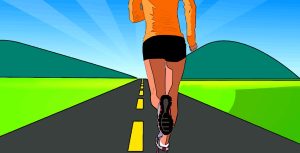
If you suffer with COPD it is extremely important to exercise as this not only strengthens your cardio-respiratory system to aid in the improvement of your condition but strengthens you physically to be able to perform day-to-day tasks more easily. Being outside and socialising while you exercise also gets you out of the house and improves your quality of life. The less exercise you do then the less you are able to do. Weaker muscles need more oxygen to be able to work so you become more short of breath just from doing simple tasks like cooking. It is difficult to exercise what with the added hassle of oxygen equipment and some patients find it easier to just stay indoors. However with the use of portable concentrators it’s now easier to get out and about on oxygen therapy and the importance of exercising with a respiratory condition has been proven to be ever more so.
The goal is to try and exercise for 20-30 mins at least 3 times a week. Combining cardio activities with strength training ones. If you’re just starting then even a couple of minutes is beneficial and you can slowly work your way up as you become physically fitter. Some find it more fun or easier if they have a friend as an exercise buddy and if they plan their week to incorporate exercise into their schedule. Keeping an exercise journal also helps in planning and recording your activities which will keep you motivated as you see your exercise levels increase.
Walking:
Walking is an easy choice that everyone can do, especially good if you;re just starting out. Whether it’s around a shopping centre, outside or on a treadmill. Take it at a slow pace to start with and add 30 secs or 10 yards each time.
Biking:
Some people enjoy using a stationary bike as they can have one in the comfort of their own home. Although at a gym you’ll have supervision and can meet other people. If you want to join a class just check with the instructor to ensure it matches your abilities. As you improve you can bike outside in the fresh air and perhaps do it with others.
Arm Curls:
Lifting light weights can help build up your arm muscles so that reaching a high shelf or carrying items is easier. Use hand weights, stretchy bands or water bottles to try arm curls. Hold the weights at your side with palms forward and breathe in. Then lift towards your chest keeping your elbows down and slowly exhale. Then slowly lower your arms back down as you breathe in. Build your repetitions up slowly.
Forward Arm Raises:
To do these hold weights down at your sides with your palms facing in and inhale. Then slowly exhale as you raise both your straight out in front of you up to shoulder height. Then inhale as you slowly lower your arms. This exercise will strengthen your upper arms and shoulders. Start with light weights and build up your repetitions and then you can increase to heavier weights and slowly build up the repetitions .
Calf Raises:
This exercise will strengthen your calf muscles to help you to be able to walk easier and further. Stand 6-12 inches behind a chair with your feet hip-width apart and use the chair for balance and support. Then lift yourself up high on your toes while you exhale slowly. Hold the position briefly and then lower your heels back to the ground. As you get stronger you can try doing just one leg at a time. Slowly work up the repetitions.
Leg Extensions:
In order to strengthen your thighs you can sit in a chair, inhale and then stretch one leg out as straight as you can and then breathe in slowly, as you lower your foot back to the floor. Do one set at a time and then as your muscles strengthen you can add ankle weights. Again slowly work up your repetitions.
Diaphragm:
A stronger diaphragm will make breathing easier for you. Lie down with your knees bent or you can sit in a comfortable chair. Place one hand on your chest and one below your ribcage. Slowly inhale and your lower hand will rise. Purse your lips and exhale while you tighten your stomach. Your upper hand should remain still throughout. Do this exercise for 5-10 min3 or 4 times a day.
Chair Dancing:
This can be a more fun exercise if you enjoy dancing. You can buy DVD’s to do at home and then you can do the workouts to your own favourite genre of music. There are different levels that you can work your way through and you can add weights to increase the challenge.
Tai Chi:
Many COPD patients find Tai Chi relaxing as it eases stress while providing a mild workout for your heart and lungs and helps to tone your muscles. There are DVDs or classes that you can join.
You should make sure you stretch your muscles briefly before exercising so that you don’t do yourself any damage.
Other fun exercises can be jogging, skating, rowing or swimming. These are more sociable and more fun. Water aerobics is good for COPD and arthritis.
Make sure that if your COPD symptoms begin acting up or if you feel tired or muscle pain then give yourself a day off from exercising until you start feeling better.
References: http://www.webmd.com




